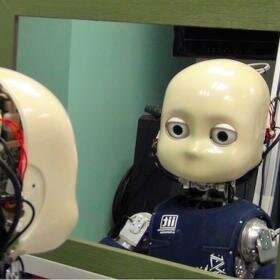July Machine Learning and Artificial Intelligence News Digest
Hello reader! Having filtered out a large number of sources and subscriptions for you, I collected all the most significant news from the world of machine learning and artificial intelligence for July. Do not forget to share with colleagues, or simply with those who are interested in such news.
For those who have not read the digest for June, you can read it here .
So, now the July digest itself.
1. VKontakte published a library for pre-processing text data. YouTokenToMe is a text data preprocessing library. The tool works 7-10 times faster than analogues for texts in alphabetical languages and 40-50 in hieroglyphic languages. The library was developed by researchers from VKontakte. → Read more

2. Data on Russians will be allowed to be used without their knowledge. Amendments to the law "On Personal Data" were presented to the government by the vice speaker of the Federation Council Andrei Turchak. It follows from them that the owner of the data will be required to anonymize them so that no additional information will help to reveal the person.

→ Read more
3. Researchers at Stanford have trained a neural network that, after watching a training video, reproduces a sequence of actions to achieve a goal.

→ Read more
4. Virtualization based on artificial intelligence demystifies the science of data using virtual reality.

→ Read more
5. Who and how uses face recognition technology in Russia. Experts say a significant shift in the focus of the application of face recognition technology from the state to the commercial sector in recent years.

→ Read more
6. NASA's satellite, looking for a planet, has discovered three new worlds that revolve around the nearest dwarf star, which is smaller and colder than our Sun. Planets are generally interesting for researchers, because they all have a size of 1.5 to 2 times the size of the Earth.

→ Read more
7. Updated map of artificial intelligence from Rusbase. The map shows AI product development companies from six segments: Predictive analytics and data mining; Natural language processing; Computer vision; Speech Technology; Biometrics; Tools for creating AI.

→ Read more
8. The neural network has learned to find spoilers and tag spoil reviews and content before the opportunity to read everything appears.

→ Read more
9. In the Italian design studio Ultravioletto, they developed the Neural Mirror mirror, which turns a person into many information points - this is how global corporations see us.

→ Read more
10. Neuromorphic computing is an approach to effectively solving complex problems of learning and cognition, such as the human brain, using electronics. To effectively implement the functionality of biological neurons, nanodevices and their implementation in chains are used.

→ Read more
11. DeepEyedentification: identification of people based on micro eye movements. Past studies of cognitive psychology show that eye movements can vary significantly from one person to another.

→ Read more
12. Researchers at the Flatiron Institute have developed a 3D simulation of the universe based on neural networks. The simulator will help astrophysicists study the effects of factors on the development of space. D3M learns to predict the space structure nonlinearly and more accurately than the basic 2LPT model. Researchers have published code and data in a repository on GitHub .

→ Read more
13. The Adobe Customer Experience Platform provides a place to process all the data that will ultimately become the basis for customer experience applications in the Adobe Experience Cloud.

→ Read more
14. Neuralink from Elon Musk, will begin to equip the human brain with “threads”, starting next year.

→ Read more
15. In China, artificial intelligence recognizes dogs by nose prints. The new Megvii program is able to recognize dogs by their nose prints - they are as unique as people's fingerprints. Users of the Megvii application can register their pet simply by scanning their nose using the smartphone’s camera.

→ Read more
16. Reliable neural machine translation. In recent years, Neural Machine Translation (NMT) using Transformer models has been a huge success. Based on deep neural networks, NMT models typically go through end-to-end training on very large parallel cases (text I / O pairs) entirely based on data and without the need to impose explicit language rules.

→ Read more
17. Parrotron: new research to improve verbal communication for people with speech disorders. Most people take it for granted that when they speak, they will be heard and understood. But for millions of people who live with speech impairment caused by physical or neurological conditions, trying to communicate with other people can be difficult and frustrating.
→ Read more
18. Cancer recognition and diagnosis is a complex and difficult process even for dedicated medical professionals who earn a living. A new tool from Google researchers can improve this process by providing what constitutes reverse image search for suspicious or known cancer cells.
→ Read more
19. An AI-based tool predicts cell behavior during illness and their treatment.

→ Read more
20. Today, the latest developments in the field of AI always attract a lot of attention, but a programmer researcher at the US Naval Research Laboratory believes that one method of AI can do a lot.

→ Read more
21. In the shoes of a robot: the future is drawing near. Identifying with someone is an exercise that helps us understand them deeply, empathize with them, and helps us overcome distrust and prejudice. And this happens even when this person is a robot.

→ Read more
22. Google's autonomous driving division and researchers at Waymo have been training a lot to refine and enhance the artificial intelligence that drives the car on their own.

→ Read more
23. AWS's new text-to-speech engine sounds like an announcer.

→ Read more
24. Cell life, death and everything in between. The discovery that apparently dead cells can sometimes resurrect themselves makes researchers investigate how far they can go to the point of no return.

→ Read more
25. Quantum Darwinism, an idea that explains objective reality - is being tested for the first time. Three experiments tested a theory explaining how quantum possibilities can lead to objective, classical reality.

→ Read more
On this our short digest came to an end. Draw conclusions and work productively. Do not forget to share the article with colleagues. Do not skip articles and news digests, you will be helped by subscribing to my telegram channel Neuron (@neurondata), as well as subscribing to my account in Habré , do not miss the following digests.
All knowledge!
For those who have not read the digest for June, you can read it here .
So, now the July digest itself.
1. VKontakte published a library for pre-processing text data. YouTokenToMe is a text data preprocessing library. The tool works 7-10 times faster than analogues for texts in alphabetical languages and 40-50 in hieroglyphic languages. The library was developed by researchers from VKontakte. → Read more

2. Data on Russians will be allowed to be used without their knowledge. Amendments to the law "On Personal Data" were presented to the government by the vice speaker of the Federation Council Andrei Turchak. It follows from them that the owner of the data will be required to anonymize them so that no additional information will help to reveal the person.

→ Read more
3. Researchers at Stanford have trained a neural network that, after watching a training video, reproduces a sequence of actions to achieve a goal.

→ Read more
4. Virtualization based on artificial intelligence demystifies the science of data using virtual reality.

→ Read more
5. Who and how uses face recognition technology in Russia. Experts say a significant shift in the focus of the application of face recognition technology from the state to the commercial sector in recent years.

→ Read more
6. NASA's satellite, looking for a planet, has discovered three new worlds that revolve around the nearest dwarf star, which is smaller and colder than our Sun. Planets are generally interesting for researchers, because they all have a size of 1.5 to 2 times the size of the Earth.

→ Read more
7. Updated map of artificial intelligence from Rusbase. The map shows AI product development companies from six segments: Predictive analytics and data mining; Natural language processing; Computer vision; Speech Technology; Biometrics; Tools for creating AI.

→ Read more
8. The neural network has learned to find spoilers and tag spoil reviews and content before the opportunity to read everything appears.

→ Read more
9. In the Italian design studio Ultravioletto, they developed the Neural Mirror mirror, which turns a person into many information points - this is how global corporations see us.

→ Read more
10. Neuromorphic computing is an approach to effectively solving complex problems of learning and cognition, such as the human brain, using electronics. To effectively implement the functionality of biological neurons, nanodevices and their implementation in chains are used.

→ Read more
11. DeepEyedentification: identification of people based on micro eye movements. Past studies of cognitive psychology show that eye movements can vary significantly from one person to another.

→ Read more
12. Researchers at the Flatiron Institute have developed a 3D simulation of the universe based on neural networks. The simulator will help astrophysicists study the effects of factors on the development of space. D3M learns to predict the space structure nonlinearly and more accurately than the basic 2LPT model. Researchers have published code and data in a repository on GitHub .

→ Read more
13. The Adobe Customer Experience Platform provides a place to process all the data that will ultimately become the basis for customer experience applications in the Adobe Experience Cloud.

→ Read more
14. Neuralink from Elon Musk, will begin to equip the human brain with “threads”, starting next year.

→ Read more
15. In China, artificial intelligence recognizes dogs by nose prints. The new Megvii program is able to recognize dogs by their nose prints - they are as unique as people's fingerprints. Users of the Megvii application can register their pet simply by scanning their nose using the smartphone’s camera.

→ Read more
16. Reliable neural machine translation. In recent years, Neural Machine Translation (NMT) using Transformer models has been a huge success. Based on deep neural networks, NMT models typically go through end-to-end training on very large parallel cases (text I / O pairs) entirely based on data and without the need to impose explicit language rules.

→ Read more
17. Parrotron: new research to improve verbal communication for people with speech disorders. Most people take it for granted that when they speak, they will be heard and understood. But for millions of people who live with speech impairment caused by physical or neurological conditions, trying to communicate with other people can be difficult and frustrating.
→ Read more
18. Cancer recognition and diagnosis is a complex and difficult process even for dedicated medical professionals who earn a living. A new tool from Google researchers can improve this process by providing what constitutes reverse image search for suspicious or known cancer cells.
→ Read more
19. An AI-based tool predicts cell behavior during illness and their treatment.

→ Read more
20. Today, the latest developments in the field of AI always attract a lot of attention, but a programmer researcher at the US Naval Research Laboratory believes that one method of AI can do a lot.

→ Read more
21. In the shoes of a robot: the future is drawing near. Identifying with someone is an exercise that helps us understand them deeply, empathize with them, and helps us overcome distrust and prejudice. And this happens even when this person is a robot.

→ Read more
22. Google's autonomous driving division and researchers at Waymo have been training a lot to refine and enhance the artificial intelligence that drives the car on their own.

→ Read more
23. AWS's new text-to-speech engine sounds like an announcer.

→ Read more
Bonus
24. Cell life, death and everything in between. The discovery that apparently dead cells can sometimes resurrect themselves makes researchers investigate how far they can go to the point of no return.

→ Read more
25. Quantum Darwinism, an idea that explains objective reality - is being tested for the first time. Three experiments tested a theory explaining how quantum possibilities can lead to objective, classical reality.

→ Read more
On this our short digest came to an end. Draw conclusions and work productively. Do not forget to share the article with colleagues. Do not skip articles and news digests, you will be helped by subscribing to my telegram channel Neuron (@neurondata), as well as subscribing to my account in Habré , do not miss the following digests.
All knowledge!
All Articles